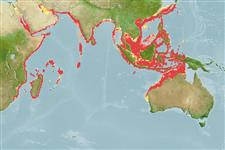>
Eupercaria/misc (Various families in series Eupercaria) >
Nemipteridae (Threadfin breams, Whiptail breams)
Etymology: Parascolopsis: Greek, para in the side of + Greek, skolos = stake + Greek, ops = appearance (Ref. 45335).
More on authors: Jordan & Richardson.
Issue
Distribution of this species is being updated. Use Stocks definition as guide for species range.
Environment: milieu / climate zone / depth range / distribution range
Écologie
marin démersal; non migrateur; profondeur 25 - 264 m (Ref. 9820). Tropical; 30°N - 28°S, 31°E - 136°E (Ref. 3810)
Western Pacific: southern Japan, Taiwan, the Philippines and Indonesia (northern Sulawesi),
Taille / Poids / Âge
Maturity: Lm ? range ? - ? cm
Max length : 35.0 cm TL mâle / non sexé; (Ref. 5450); common length : 35.0 cm TL mâle / non sexé; (Ref. 5450)
Épines dorsales (Total): 10; Rayons mous dorsaux (Total): 9; Épines anales 3; Rayons mous anaux: 7. Head scales reaching forward to between middle of eyes. Posterior margin of preopercle more or less vertical, or sloping forward slightly. Lower limb of preopercle naked. Posterior margin of suborbital serrate, a small spine at upper corner. Pectoral fins long, reaching to or almost to level of anus. Pelvic fins long, reaching to level of anus. Color: Body pinkish. An elongate blotch at origin of lateral line. Upper axis of pectoral fin black. Pectoral and caudal fin yellowish.
Benthic on sand or mud bottoms in offshore waters (Ref. 30573, 48635). Feeds mainly on benthic invertebrates. Minimum depth reported taken from Ref. 30573.
Life cycle and mating behavior
Maturité | Reproduction | Frai | Œufs | Fécondité | Larves
Miyamoto, K., C.D. McMahan and A. Kaneko, 2020. Parascolopsis akatamae, a new species of dwarf monocle bream (Perciformes: Nemipteridae) from the Indo-West Pacific, with redescription of closely related
species P. eriomma. Zootaxa 4881(1):91-103. (Ref. 123359)
Statut dans la liste rouge de l'IUCN (Ref. 130435)
Menace pour l'homme
Harmless
Utilisations par l'homme
Pêcheries: pêcheries vivrières
Plus d'informations
Noms communsSynonymesMétabolismePrédateursÉcotoxicologieReproductionMaturitéFraiRassemblement de ponteFéconditéŒufsDéveloppement de l'œuf
RéférencesAquacultureProfil d'aquacultureSouchesGénétiqueElectrophoresesHéritabilitéPathologiesTraitementNutrientsMass conversion
CollaborateursImagesStamps, Coins Misc.SonsCiguateraVitesseType de nageSurface branchialeOtolithesCerveauxVision
Outils
Articles particuliers
Télécharger en XML
Sources Internet
Estimates based on models
Preferred temperature (Ref.
123201): 19.8 - 28.1, mean 24.9 °C (based on 677 cells).
Phylogenetic diversity index (Ref.
82804): PD
50 = 0.5002 [Uniqueness, from 0.5 = low to 2.0 = high].
Bayesian length-weight: a=0.02089 (0.01189 - 0.03673), b=2.99 (2.84 - 3.14), in cm total length, based on LWR estimates for this species & (Sub)family-body (Ref.
93245).
Niveau trophique (Ref.
69278): 3.5 ±0.44 se; based on food items.
Résilience (Ref.
120179): Milieu, temps minimum de doublement de population : 1,4 à 4,4 années (Preliminary K or Fecundity.).
Fishing Vulnerability (Ref.
59153): Low vulnerability (25 of 100).
